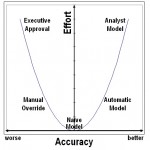The March 28 edition of APICS extra features an article by Fred Tolbert on "The Seven Deadly Sins of Sales Forecasting." Although I have some objection to his Deadly Sin #1: Using Shipment History (and will discuss the objection in a forthcoming guest-post on the Institute of Business Forecasting blog), I particularly liked Deadly Sin #5: Senior Management Meddling:
If your weekly or monthly demand planning meeting involves the company president, CFO, vice president of sales, or vice president of operations, it is almost certain the fifth deadly sin is going to occur. Senior executives have no business exerting their bias or influence on the SKU forecasts.
The sales forecast should be the company's best estimate of customer demand. It is inappropriate for executives to adjust the forecast as a means of manipulating inventory levels and fill rates. Inventory and service levels are best managed as part of the supply planning and inventory replenishment processes. Unfortunately, this sin is the easiest to recognize and the toughest to do anything about.
The forecasting process at many organizations includes a final "Executive Approval" step. But why should the CEO, General Manager, or other high-ranking objective spend time changing a forecast created by the organization's forecasters? If the forecasters are competent, then the executive approval step is a waste. And if the forecasters are not competent, why are they in that role? You don't have to count all the way to Catch 22 to see that this doesn't make any sense.
Demand Forecasting ≠ Sales & Operations Planning
It is important to distinguish the authority of executive management in the demand forecast (which I oppose), to their very legitimate authority in Executive S&OP - the aggregate, high-level component of Sales & Operations Planning. It is executive management's role to establish service, inventory, and financial targets, to authorize spending, and to make other decisions about supply and demand balance, arriving at an operating plan that allocates resources to meet organizational objectives.
I want my forecasting professionals to communicate the voice of the marketplace. Senior management helps address how we deliver to that voice.
 In the next installment we'll consider a graphical representation of this sin, the Accuracy vs. Effort chart.
In the next installment we'll consider a graphical representation of this sin, the Accuracy vs. Effort chart.

1 Comment
Pingback: Editorial comment: Forecast accuracy vs. effort - The Business Forecasting Deal